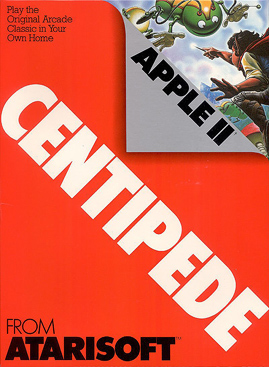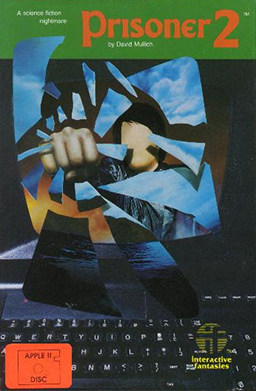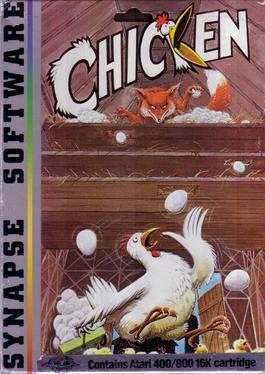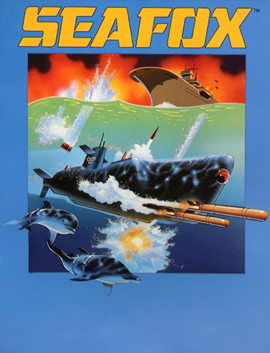
Centipede is a 1981 fixed shooter arcade video game developed and published by Atari, Inc. Designed by Dona Bailey and Ed Logg, it was one of the most commercially successful games from the golden age of arcade video games and one of the first with a significant female player base. The primary objective is to shoot all the segments of a centipede that winds down the playing field. An arcade sequel, Millipede, followed in 1982.

Miner 2049er is a platform game game developed by Big Five Software and published in December 1982. It is set in a mine, where the player controls the Mountie Bounty Bob. The player controls Bounty Bob through multiple levels of a mine, with the goal of traversing all of the platforms in each level all while avoiding enemies and within a set amount of time.

Shamus is a shooter with light action-adventure game elements written by Cathryn Mataga and published by Synapse Software. The original Atari 8-bit computer version was released on disk and tape in 1982. According to Synapse co-founder Ihor Wolosenko, Shamus made the company famous by giving it a reputation for quality. "Funeral March of a Marionette", the theme song from Alfred Hitchcock Presents, plays on the title screen.

Atarisoft was a brand name used by Atari, Inc. in 1983 and 1984 to publish video games for non-Atari home computers and consoles. Each platform had a specific color for its game packages: video games sold for the Commodore 64 were in green boxes, games for the TI-99/4A in yellow, the IBM PC in blue, and so on.
Synapse Software Corporation was an American software developer and publisher founded in 1981 by Ihor Wolosenko and Ken Grant. Synapse published application software and developer tools and was primarily known for video games. It initially focused on the Atari 8-bit computers, then later developed for the Commodore 64 and other systems. Synapse was purchased by Broderbund in late 1984 and the Synapse label retired in 1985.

N.Y.C. The Big Apple is an action game written by Russ Segal for Atari 8-bit computers and published by Synapse Software in 1984. Segal previously wrote Picnic Paranoia for Synapse. New York City was ported to the Commodore 64 by Greg Nelson.

The Prisoner 2 is a video game published in 1982 by Edu-Ware. It is a remake of the 1980 game The Prisoner.

Worms? is a puzzle video game written by David Maynard for Atari 8-bit computers and ported to the Commodore 64. It was released in 1983 as one of the first publications from Electronic Arts. Worms? is an interactive version of Paterson's Worms.

Serpentine is a maze video game written by David Snider for the Apple II and published by Broderbund in 1982. Serpentine's gameplay and visuals are similar to the Konami arcade game, Jungler, released the previous year. It was ported to the Commodore 64 and Atari 8-bit computers. A VIC-20 version was licensed to Creative Software.

Necromancer is an action game created by Bill Williams for Atari 8-bit computers and published by Synapse Software in 1982. A port to the Commodore 64 followed in 1983. The game was rereleased by Atari Corporation on cartridge in the style of the Atari XEGS in 1987.

Wayout is a 3D first-person perspective video game programmed by Paul Allen Edelstein and published for the Atari 8-bit computers in 1982. It was released for the Apple II and Commodore 64 in 1983. Wayout is among the first maze games to offer full 360 degree 3D perspective and movement, and its graphics were considered state-of-the-art upon its release. There were many pseudo-3D maze games at the time, but they used a fixed perspective and limited the player to four orientations.

Attack at EP-CYG-4 is a shoot 'em up video game created by Mike Edwards for Atari 8-bit computers and published by his company BRAM, Inc. in 1982. It allows two players to cooperatively control the action against a computer enemy, in a fashion similar to Synapse Software's Survivor, also released in 1982. EP-CYG-4 was the first of Edwards' game efforts, and its success led to the creation of Zombies, which was published by Electronic Arts as Realm of Impossibility.

Slime is an action game for Atari 8-bit computers written by Steve Hales and published by Synapse Software in 1982. The player attempts to protect their ship from a rain of enormous drops of slime by deflecting them into canisters, while fending off attacks by an alien flying saucer. A TI-99/4A port was developed as Super Storm, but not released.

Chicken is a video game for Atari 8-bit computers written by Mike Potter and published by Synapse Software in 1982. The game is similar to Atari, Inc.'s. 1978 arcade video game Avalanche, replacing the buckets and boulders with a hen trying to catch her eggs.

Bandits is a 1982 fixed shooter written by Tony and Benny Ngo for the Apple II and published by Sirius Software. The game is a clone of Taito's 1980 Stratovox arcade video game where the goal is to prevent aliens from stealing objects. Bandits was ported to the Atari 8-bit computers, Commodore 64, and VIC-20.

Drelbs is a maze video game written by Kelly Jones for Atari 8-bit computers and published by Synapse Software in 1983. An Apple II port by Jonathan Tifft was released the same year. A Commodore 64 version followed in 1984 implemented by Miriam Nathan and William Mandel. The objective is to move the walls of the maze to make boxes. Some reviewers found the overall collection of elements to be eccentric and unique.

Hockey is a ice hockey video game published by Gamma Software for Atari 8-bit computers in 1981. Gamma released the Atari 8-bit game Soccer the following year.

Seafox is a shoot 'em up written by Ed Hobbs and published by Broderbund in 1982 for the Apple II and as a cartridge for Atari 8-bit computers. A VIC-20 port, also on cartridge, was released in 1983.

Protector II is a video game written by Mike Potter for Atari 8-bit computers and published by Synapse Software in 1982. It is a sequel to 1981's Protector; both games are horizontally scrolling shooters inspired by the arcade video game Defender. Protector II was ported to the Commodore 64, TI-99/4A, and TRS-80 Color Computer.

Claim Jumper is a video game written by Gray Chang for Atari 8-bit computers and published by Synapse Software in 1982. It is primarily designed as a two-player competitive game, but includes a separate shoot 'em up mode for either one or two players.




















